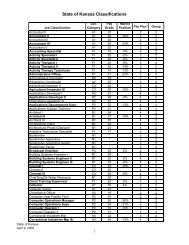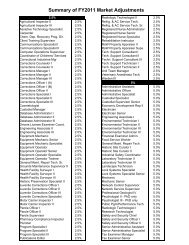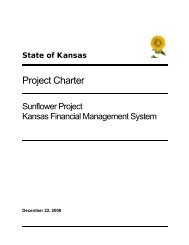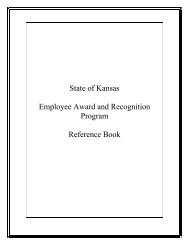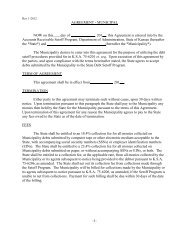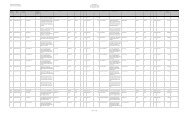Testimony - Department of Administration
Testimony - Department of Administration
Testimony - Department of Administration
You also want an ePaper? Increase the reach of your titles
YUMPU automatically turns print PDFs into web optimized ePapers that Google loves.
Update on Implementation<br />
and Discussion <strong>of</strong> Salary Surveys<br />
Before the State Employee Pay Plan Oversight Committee<br />
June 30, 2008<br />
By Kraig Knowlton and Ken Otte,<br />
<strong>Department</strong> <strong>of</strong> <strong>Administration</strong>,<br />
Division <strong>of</strong> Personnel Services<br />
Thank you for the opportunity to speak to you today about the efforts to date with respect to<br />
the implementation <strong>of</strong> the new pay plans and the new performance management process as<br />
well as the plans for the salary surveys that are to be conducted this summer.<br />
FY2009 Market Adjustments<br />
Market adjustments were provided to approximately 7,800 employees in 181 classifications<br />
in FY2009. These employees received at least a 5% increase in addition to the 2.5% general<br />
increase received by all classified employees. Market adjustments were accomplished<br />
through a combination <strong>of</strong> pay grade adjustments, in-grade increases and class consolidation.<br />
The specific details <strong>of</strong> the FY2009 market adjustments are set out in Executive Directive 08-<br />
388, which we understand has been provided to the Committee.<br />
The same methodology utilized by the Legislature in providing market adjustments in<br />
FY2008 was used to determine which classifications would receive market adjustments in<br />
FY2009, so market position as identified in the Hay Group’s survey (see Attachment I) was<br />
the primary basis. In general, market adjustments were provided to classifications identified<br />
as being at least 10% or more behind market, although there were some exceptions due to<br />
issues <strong>of</strong> internal equity within occupational groups or between related occupational groups.<br />
Overall, we have received very positive feedback regarding the FY2009 market adjustments<br />
and we believe they were an excellent start to the implementation process for this historic<br />
initiative.<br />
Performance Management<br />
Since January, two teams <strong>of</strong> employees have been working with staff from the Hay Group<br />
and the Division <strong>of</strong> Personnel Services (DPS) to design a new performance management<br />
process for the State <strong>of</strong> Kansas. The first team, consisting <strong>of</strong> employees from different<br />
agencies, roles, levels <strong>of</strong> responsibility and representing classifications assigned to all five <strong>of</strong><br />
the new pay plans, have worked to design a new process, form and resource guide for the<br />
new system. The second team acted as a Steering Committee, and is made up <strong>of</strong> senior<br />
management level positions from throughout State Government.<br />
We are in the process <strong>of</strong> meeting individually with all members <strong>of</strong> the Steering Committee<br />
and have convened the Design Team one last time to discuss changes, so we are very close to<br />
moving to the next phase <strong>of</strong> the process. Once the design <strong>of</strong> the new process is complete,<br />
staff from the Hay Group and DPS will conduct train-the-trainer sessions on the new process<br />
with State <strong>of</strong> Kansas trainers. Following these classes, State <strong>of</strong> Kansas trainers will begin<br />
<strong>Department</strong> <strong>of</strong> <strong>Administration</strong><br />
Division <strong>of</strong> Personnel Services<br />
June 30, 2008
delivering training to employees on the new process. We are hopeful that we can complete<br />
this effort by this Fall, but we may not be able to complete all <strong>of</strong> the training until the end <strong>of</strong><br />
the year.<br />
Given the diverse array <strong>of</strong> employees and managers who have helped to design and finalize<br />
the new process, we believe that this new performance management process will serve as an<br />
effective method for the on-going communication between employees and management staff.<br />
This will ensure employee’s focus is properly aligned with the organizational needs <strong>of</strong> the<br />
agency and will provide the employee a clear method for advancing in their career.<br />
Salary Surveys<br />
This summer, the <strong>Department</strong> <strong>of</strong> <strong>Administration</strong> will begin conducting salary surveys on onethird<br />
<strong>of</strong> the classified workforce in accordance with Senate Substitute for H.B. 2916. This<br />
survey will be somewhat different in design than the Hay Group’s 2006 salary survey. That<br />
survey was designed to cover a broad spectrum <strong>of</strong> the State’s classified workforce and<br />
provide data to demonstrate our overall market position with respect to our relevant market.<br />
Therefore, the Hay Group’s survey was sent to 100 employers and each employer received<br />
the same set <strong>of</strong> 232 benchmarks to compare with positions in their own organization.<br />
Our primary goal with respect to this summer’s survey will be to gather data for use in<br />
developing the recommendations for FY 2010, where we will be seeking to bring the wages<br />
<strong>of</strong> employees in Group 1 as close to market as possible as well as to begin the development<br />
<strong>of</strong> the Basic Vocational Pay Plan, the General Classified Pay Plan and the Pr<strong>of</strong>essional<br />
Individual Contributor Pay Plan for the classifications in Group 1. At latest count, we are<br />
planning to send surveys to between 350 to 400 employers, and each employer will receive<br />
the benchmarks that they are likely to have positions with which to compare with those <strong>of</strong> the<br />
State.<br />
In developing the survey for this summer, we have asked agencies and employee<br />
organizations to provide us with the names and contact information <strong>of</strong> employers who should<br />
be included in the survey. This step was taken to help ensure that we are comparing with<br />
employers with whom we compete in attracting and retaining employees.<br />
We hope to be able to send out the survey instruments by the end <strong>of</strong> next week and we will<br />
ask that they be returned by the employers no later than August 6, 2008. This will allow us<br />
time to compile and analyze the data so that projections and recommendations can be made<br />
to this Committee and the Division <strong>of</strong> Budget for FY2010. However, before we finalize our<br />
plans, we would like to obtain the Committee’s input on five specific issues with respect to<br />
the surveys this summer.<br />
1 – Survey by Group<br />
The first point on which we would like to obtain the Committee’s guidance has to do with the<br />
survey schedule. As established by the Legislature, we are required to survey one-third <strong>of</strong><br />
the classified workforce annually. Since the workforce has been divided into three Groups<br />
for the purposes <strong>of</strong> implementation, we would propose surveying according to these Groups.<br />
This will follow the implementation schedule set out by the Oversight Commission and<br />
adopted by the Legislature and will also help to clarify exactly which classifications are being<br />
surveyed in which year. If the Committee is in agreement with this proposal, the salary<br />
<strong>Department</strong> <strong>of</strong> <strong>Administration</strong><br />
Division <strong>of</strong> Personnel Services<br />
June 30, 2007<br />
2
survey conducted this summer will focus exclusively on those classifications assigned to<br />
Group I.<br />
2 – Comparator Group<br />
The next issue has to do with the size <strong>of</strong> the comparator group to which the State should<br />
compare for the purposes <strong>of</strong> establishing market. While private and public employers within<br />
the State <strong>of</strong> Kansas are our primary competitors for employees, we believe that it is also<br />
important to include other states in our surveys. There are some types <strong>of</strong> positions which do<br />
not exist outside <strong>of</strong> state government, and if we want to compare our salaries with another<br />
employer, we can only do so with other states.<br />
For the Hay Group’s survey, it was determined that only the eight surrounding states should<br />
be used as comparisons. However, the State <strong>of</strong> Kansas is a founding member <strong>of</strong> the Central<br />
States Compensation Association (CSCA) and participates in annual salary surveys with the<br />
25 other states that make up the CSCA as well (see Attachment II).<br />
Based on a request from the Kansas Organization <strong>of</strong> State Employees (KOSE), we would<br />
propose that the entire CSCA be included for comparative purposes. We would request the<br />
Committee’s approval <strong>of</strong> this expansion.<br />
3 – Industry/Relevant Market<br />
Regardless <strong>of</strong> whether the comparator group is expanded to include the entire CSCA or just<br />
the eight states utilized in the Hay Group’s survey, it is important that we distinguish between<br />
the relevant labor market and the industry labor market. As stated above, private and public<br />
employers within the State <strong>of</strong> Kansas are the State’s primary competition for employees, so<br />
we would consider them to be our relevant labor market while we would consider other<br />
states to be our industry labor market.<br />
Where job matches can only be found in other states, the market rates for such positions<br />
would be based on data exclusively from other state governments. However, where job<br />
matches are obtained from both in-state employers and other state governments, we believe<br />
that the data should be weighted to reflect the fact that the relevant labor market is the State’s<br />
primary competition so we would recommend that the data be weighted 75/25 to in-state<br />
employers. This policy will ensure that the data from other state governments does not<br />
overwhelm the data from the in-state employers with whom the State <strong>of</strong> Kansas actually and<br />
regularly competes.<br />
In addition, the value <strong>of</strong> data from other states is questionable for those jobs which command<br />
lower wage rates and where recruitment and retention efforts are very geographically limited.<br />
Jobs such as these include such occupations as custodial workers, food service workers and<br />
laundry workers and are to be assigned to the Basic Vocational Pay Plan. Therefore, we<br />
would also recommend that market comparisons for jobs assigned to the Basic Vocational<br />
Pay Plan be limited to in-state employers, who constitute the relevant labor market.<br />
We believe that these policies will help to ensure that we are obtaining relevant, reliable data<br />
from employers with whom we actually compete. We would like to make sure that the<br />
Committee approves <strong>of</strong> these policies so that our methodology reflects the intent <strong>of</strong> the<br />
Committee.<br />
<strong>Department</strong> <strong>of</strong> <strong>Administration</strong><br />
Division <strong>of</strong> Personnel Services<br />
June 30, 2007<br />
3
4 – Basis for Adjustments<br />
The next point which we would like to raise for the Committee today is essentially a<br />
confirmation <strong>of</strong> the intent <strong>of</strong> these surveys. One <strong>of</strong> the primary reasons for commissioning<br />
the Hay Group to conduct a salary survey in 2006 was to obtain a single source <strong>of</strong> data on<br />
which compensation decisions would be based. Given the multitude <strong>of</strong> different sources <strong>of</strong><br />
data available, we believe that is a very important concept.<br />
Therefore, we would like to confirm with the Committee that the only surveys on which<br />
compensation decisions for classified employees in the State <strong>of</strong> Kansas will be based will be<br />
the Hay Group’s 2006 survey, any surveys conducted by the <strong>Department</strong> <strong>of</strong> <strong>Administration</strong><br />
(in accordance with the Committee’s decision on issue #2 above) and any other survey<br />
authorized by this Committee. We believe this is important to establish at the beginning <strong>of</strong><br />
this process and will avoid a great deal <strong>of</strong> confusion and conflict as we move forward with<br />
implementation.<br />
5 – Data from Private Employers<br />
Finally, private employers represent a major component <strong>of</strong> the relevant labor market with<br />
which the State <strong>of</strong> Kansas competes for employees. We believe that it is imperative that we<br />
receive data from these employers in order to have an accurate understanding <strong>of</strong> the market.<br />
The Hay Group’s survey included 45 private employers (including healthcare facilities) in its<br />
survey and 33 <strong>of</strong> those private employers responded.<br />
One <strong>of</strong> the reasons that the Hay Group was able to obtain such a good response rate from<br />
private employers is that the Hay Group assures the confidentiality <strong>of</strong> the salary data that<br />
employers provide, and that results <strong>of</strong> the survey will only be published in aggregate form.<br />
While wage data from public sector employers may be a matter <strong>of</strong> open record, many private<br />
employers go to great lengths to ensure wage data for their employees is held in the strictest<br />
<strong>of</strong> confidence.<br />
Due to the historic nature <strong>of</strong> this initiative and the importance <strong>of</strong> the survey data in making<br />
decisions, we anticipate receiving requests under the Open Records Act to publicize the<br />
individual rates <strong>of</strong> private employers. We are very concerned that if that were to happen,<br />
many private employers would not participate in our salary surveys. While we believe that<br />
this process should be as open as possible, we do not wish for that openness to prevent us<br />
from obtaining data from employers with whom we compete for employees, and potentially<br />
skewing the market data that we receive. We are open to suggestions from the Committee on<br />
how to address this issue.<br />
Once again, we would like to thank the Committee for the opportunity to present this<br />
information today and we would be happy to stand for any questions.<br />
<strong>Department</strong> <strong>of</strong> <strong>Administration</strong><br />
Division <strong>of</strong> Personnel Services<br />
June 30, 2007<br />
4



